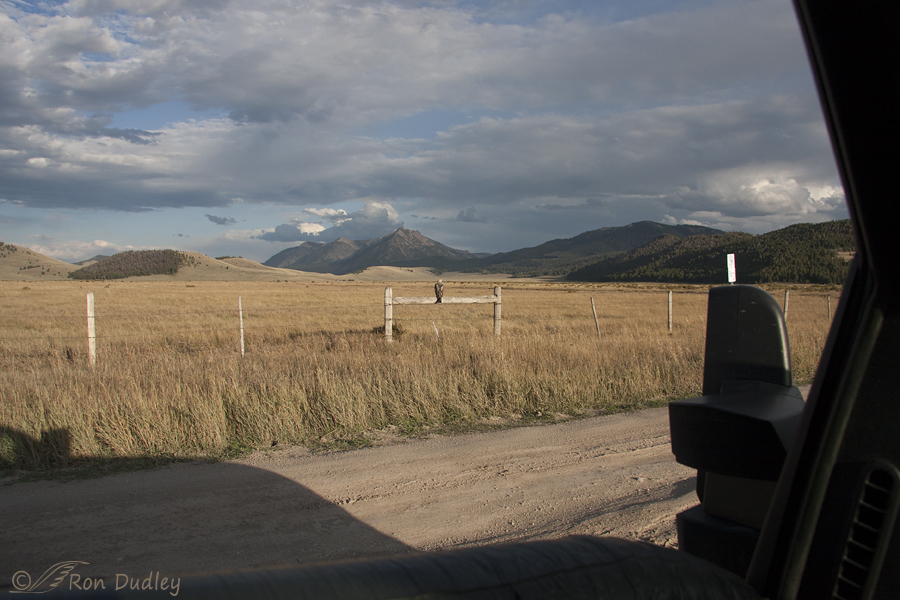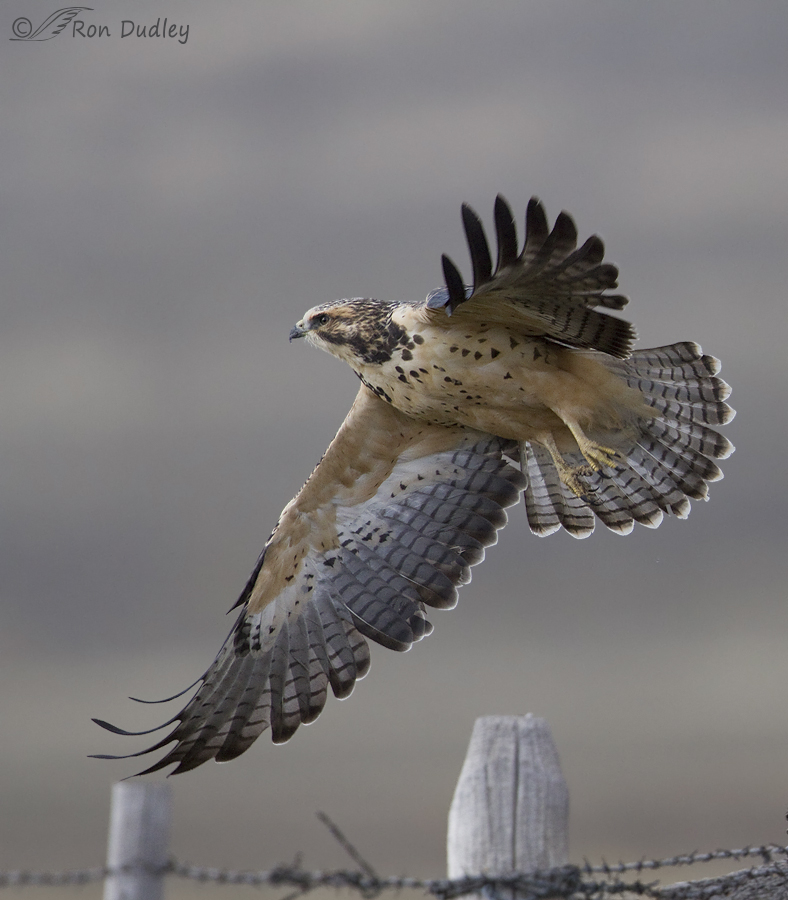Any bird photographer knows that light and timing have a nasty habit of being uncooperative just when you need that cooperation most. While I was photographing Swainson’s Hawks in Montana last week I had more than my share of bad luck with light. Thanks to blustery skies my two best days with those hawks were usually in constantly changing light that made proper exposure, enough shutter speed for flight shots and catch lights in the eye elusive and largely unobtainable.

1/1000, f/8, ISO 500, Canon 7D, Canon EF-S17-85mm f/4-5.6 IS USM @ 17mm, not baited, set up or called in
This is the “butterscotch” juvenile that I spent so much time with (another juvenile and an adult parent were always nearby but they were less cooperative). Notice that this shot from inside my pickup was taken at only 17 mm (literally wide-angle) so the bird was quite close. When I would get a few minutes of beautiful light like this the bird would typically sit there with its back to me as it scanned the landscape for grasshoppers and do nothing. I had plenty of static shots of the hawk as it perched on these fence posts so I was mostly after take-off and flight shots. I spent a lot of time looking through my lens at this bird waiting for something to happen.
But exactly five minutes before this image was taken the clouds had rolled in and the hawk naturally…

1/1250, f/5.6, ISO 640, Canon 7D, Canon EF500mm f/4L IS II USM +1.4 tc, not baited, set up or called in
chose that less than ideal time to take off from a different post and give me an appealing flight pose as it did so. I don’t keep (or even attempt) many flight shots taken in shade but I like the posture with the spread tail that gives the viewer such a nice look at the ventral plumage and I did get lucky with one thing – a bright area in the clouds behind me gave me a catch light in the eye, despite the overall gloomy conditions. Some won’t like the wire at the bottom of the frame but these hawks love those fences so who am I to quibble over a little rusty wire…
Truth be told it was likely “operator error” that saved this photo. It was moderately underexposed in camera and I had to bring it back up during processing. If the image had been properly exposed when it was taken I likely wouldn’t have had enough shutter speed to get the hawk as sharp as it is.
Ron


You know how I hate barbed wire…in fact I’m not crazy about any kind of fencing…or “caging”, even though I am aware of it’s value and “necessity”. I particularly like the “unbounded freedodom to fly over obstacles “… like fencing, that these images represent…that’s especially illustrated in the second frame…”Upmand over, beautiful, free flying creature!”
HI Great photo! Love the bright colors! You did a good job on this bird! Have a great day!
BREATHTAKING!!!
Your photos are so inspiring Ron.
Very nice of you to say so, Jenny. I try – sometimes it works, sometimes it doesn’t but I keep plugging away. Part of the fun…
Patience rewarded. Beautifully. I love the curl to the feathers. And the detail. And the background is so very right.
Such a glorious sight to see. Thank you.
Thanks very much, Elephant’s Child.
I love the quality of light and color in this photograph. Cloudy conditions are undoubtedly challenging to the photographer, but to my eye, the richness and subtlety expressed in shots like this are superior to full-sun images. Congratulations and thanks for sharing such a wonderful image with us.
Interesting point about the light, Tim. Often I’d agree with you, for me it depends on the image though…
What I like most about your photos is: I can see each feather. It looks like I could reach out and stroke them. SHARP!!! Thank you.
I appreciate your sharpness observation, Karen. I always try to achieve sharpness but often don’t succeed (thank goodness I don’t have to post everything I shoot!)
This is a beautiful shot. I don’t mind either the clouds or the barbwire fencing – I like seeing the birds in the context of their natural surroundings. It is also interesting that the background elements pick up so many of the colors in the bird.
Good point about the background colors, Susan. I should have explained that the background is a low mountain, not clouds.
I love how the tips of the tail and flights are highlighted. 😀
Me too, Arwen.
Lovely photo. I’m so looking forward to seeing how your photography is supported by the new camera you’re acquiring!
I’m looking forward to it too, Alison – like a kid before Christmas…
You make me feel better about my shots of Redtail and Rough-legged back shots! This shot is excellent, beautiful contrast, fantastic hawk, wonderful pose!! Oh for the wide open spaces.
Yes, those wide opens spaces are great, Dick. I wish them on you !
Boy, do we all know exactly what you mean! Having said that, what a sensational shot you got conditions and all. It takes great skill and talent to come up with a shot like this!
Charlotte
Thanks very much, Charlotte.
Wonderful Portrait Ron !
Thank you, John.
Astonishing. Beautiful photo. And getting it under such conditions Wow I take my hat off.
Forgive me for asking but to catch the light in the eye, the sun must always be behind you or can it be elsewhere? (except in front of you of course)
Thank you for showing us the scenery where you usually take your photos.
Thanks, Jorge. And I’m happy to answer your question about catch lights.
Catch lights are easiest to get when the sun is behind you and low in the sky but it doesn’t have to be directly behind you – there’s a lot of leeway. It often becomes more difficult to get them the further to the side the light source is. That’s also related to the reason light in the eye is difficult to get when the sun is high in the sky. That said, it isn’t unusual to get light in the eye from unexpected sources. I’ve got it from reflections off of nearby cars and water, for example – even when the sun was behind the bird. Even bright clouds behind you when the sun is on the other side of the bird can provide light in the eye.
More on catch lights here if you’re interested. https://www.featheredphotography.com/blog/2011/12/13/catch-lights-in-bird-photography/
So much to learn…
Thank you Ron.